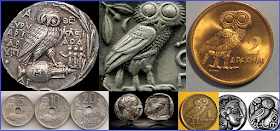Apart from the famous Gods and Goddesses of Greek Religion who live on Mount Olympus, there are older deities preceding them. The Olympians are, in fact, the third Divine Generation in Greece.
Characteristics of the Primordial Deities
The Primordial Gods and Goddesses in Greek Religion are linked with the immense depths of the past, when the cosmos was created. As they rose along with life itself, they shaped the basis on which all existence, mortal and immortal, developed. Even though They are depicted as men or women in some of their artistic representations, Primordial Gods resemble more that which each of Them represents. Because of this, They have always seemed more distant towards humans. This distance, though totally different from the overall attitude of the Olympians towards humankind, did not diminish the importance of the Primordial Gods within the Greek Religion.
Thalassa, the Greek Goddess of the sea, is one of the most significant Primordial Deities before the Olympians.
Thalassa’s parents are the God Aether, the God of bright, upper air, and the Goddess Hemera, the Goddess of day. Thalassa’s partner was Pontus, the pre-Olympian God of the seas. Together, they had children, including:
Telchines. These are nine beings who are also called the storm Gods and typically known as the first beings to live on the island of Rhodes.
Halia. A sea Νymph, who was the mother to seven of Poseidon’s children.
Aphrodite. Ancient sources mention Thalassa became pregnant with Aphrodite after coming in contact with Ouranos’ severed manhood.
Aigaios. Aigaios is the God of storms.
Also, Thalassa is the Mother of all the fish in the sea.
Depictions of Thalassa
While traditional representations of Thalassa are as the sea itself, other images of the sea Goddess exist as well.
In several mosaic works, Thalassa appears as a sturdy woman who is half under the sea. She wears seaweed, holds the oar of a ship in one hand and a dolphin in her other hand. Also, in these images, Thalassa has crab-claws protruding like horns from Her head.
According to fables written by Babrius Thalassa transforms into a half-submerged woman, made of water rising from the sea in order to answer to mortals who criticize Her or are disrespectful towards Her.






















































